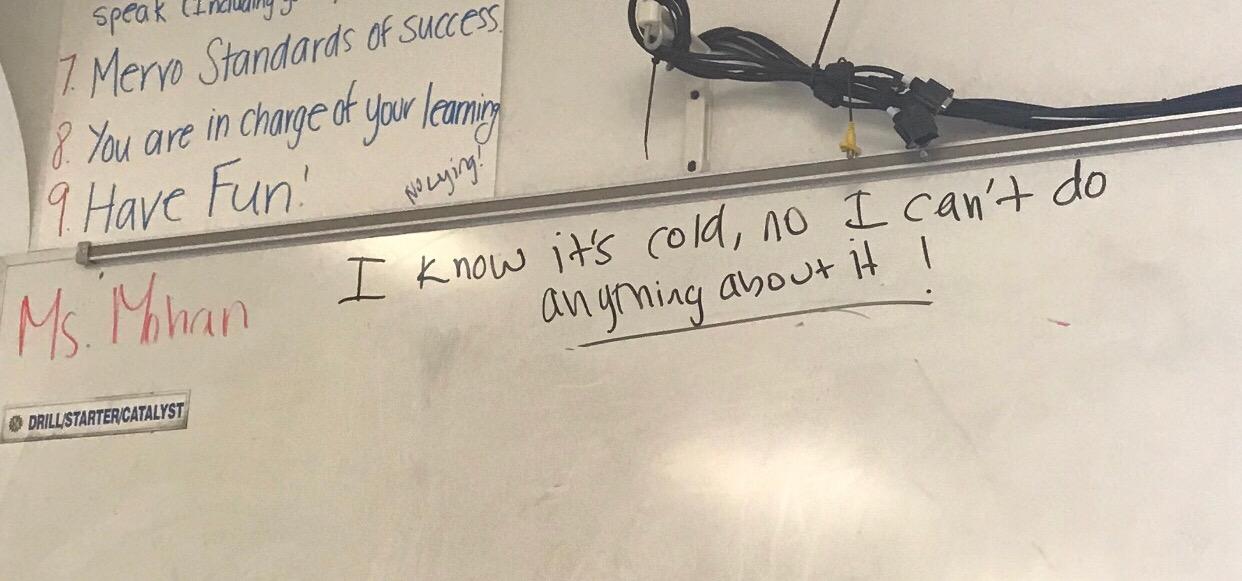Extreme temperatures pose a serious, long-term health threat for people with chronic medical conditions like asthma, respiratory diseases, obesity, diabetes, heart disease, cancer, mental illness and multiple sclerosis. We all know that people die of heat stroke in the summer or of heart attacks after shoveling snow. We know a lot less about the long-term effects on large populations of living in extreme heat and cold. Reporters at the Philip Merrill College of Journalism at the University of Maryland are working with National Public Radio and students at Wide Angle Youth Media in Baltimore on a project to look at how heat and cold in Baltimore homes affect residents' health – particularly as climate change becomes more and more significant. Learn more and get involved.
It’s hard to learn when classrooms are cold

By Kyla-Marie James
Wide Angle Youth MediaMarch 21, 2019
BALTIMORE -- In the winter, it gets very cold in some of the classrooms at Mergenthaler Vocational Technical High School (Mervo), where I’m a sophomore. In November, Ms. (Swetha) Mohan, a geometry teacher, wrote this on the board to prevent students from badgering her about the cold temperature in her classroom.
Frigid temperatures in classrooms are a big problem across Baltimore, which has some of the oldest and most rundown school buildings in the state, according to the Baltimore Sun. I decided to interview students and teachers at my school to learn how cold temperatures affect their ability to learn and teach.
Some said they are frustrated when Baltimore schools remain open in terrible weather and other counties close. Students talked about the frustration they have with the lack of heat at Mervo and the difficulty of getting to school on public transportation when its cold. Teachers talked about how hard it is to teach in a cold climate, partly because student attendance is so low.
Here are some excerpts from my interviews.
Ms. Swetha Mohan, geometry teacher, 27
“The students just couldn’t focus because they were so cold. And my room was the third coldest room in the school, so it really hindered my ability to keep the kids on task. And I mean I couldn’t blame them, it was 40 degrees in the classroom,” she said. “And yeah, like on really cold days I would get about 50 percent of all the students I teach and the kids that were there were in winter coats. It was just a very uncomfortable environment.”
“Every one of my students would walk in my classroom like, ‘Oh my gosh it's so cold.’ And I'm just like, ‘ Yes, I know, I'm in here too.’ I wish I could make it warmer, but I can’t. So, I wrote on the board, ‘I know it’s cold, but I can’t do anything’ because I was just irritated. But not with the students, just the fact that we all have to find a way to persevere through this like 40, 50 degree weather.”
“Yeah, I just think the school needs to be revamped, you know. I mean there has to be more to the schools, because it's just not fair to the students to have to come to an environment where they can’t learn on top of everything else they have to deal with. Their school building shouldn’t be a barrier for them to learn. And if they are freezing in a classroom or so hot and sweaty and feel like they're going to pass out, like, obviously our students can't learn in that kind of environment. We need to find a way and give our kids what they deserve.”
Caron Campbell, sophomore honors student, 16
“It takes me like an hour to get to school because I take two buses and it takes longer to get to school when it snows or it’s really cold outside. I wake up at like five to be on time,” he said. “It's been times when I don’t even care about school because it's so cold, but I still come because one, my mother makes me, but also I really care about having good grades.”
“Even though we have heat in school you can barely feel it. We still got to walk around in coats,” he said.
Asia Drayton, sophomore on the School Advisory Council, 16
“When it's too cold or it’s snowing outside I don’t even show up because nobody got time for that. It's hard to learn in a classroom that’s like 40 degrees,” she said.
D’Asia Carter, sophomore honors student, 16
“All they need to do is close city schools when the county is closed. We shouldn’t have to travel in the cold when they get to stay home,” she said.
Rashawn Spence, sophomore student athlete, 16
“It’s like even though we have heat in the classroom the cold climate outside cancels the little bit of heat that do come in. Some days it would feel like its air coming through the heater,” he said.
Ms. Samantha Cordisco, chemistry teacher, 28
“[On cold days] attendance decreases drastically. The last two-hour delay we had on March 1st I had 50 percent of my first period and that was only a two-hour delay. And I texted other teachers like, ‘How many kids do you have?’ I've seen numbers like eight out of 24,” she said. “What also needs to be taken into consideration is you guys that are older that catch multiple buses. Like one of my students told me that they caught four buses to get to school one time because they had to take their siblings to school. That’s a long time for that young man to have been out in that cold waiting for buses! I just wish we actually had transportation to and from schools for high schoolers as well.”





